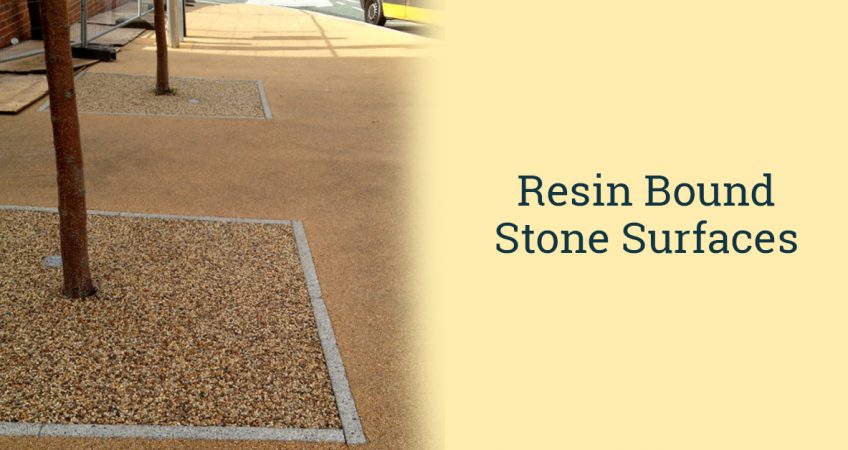A lot of housing projects in the UK these days are going for resin bound stone surfaces over other materials. The practice of building surfaces using paver blocks or concrete is on its way out. Instead, resin has emerged as a favoured choice as it lends itself well to creating efficient driveways, gardens, and paths. Resin surfaces are also known to be easy on the eyes, low on maintenance, and last for a long time.
Resin bound stone – What is it & where is it used?
Resin bound gravel involves mixing resin and natural stone together before laying the mixture over a primed surface, where it’s then trowelled to attain a level and smooth finish. Upon completion, resin bound surfaces have a depth ranging from 12 to 24mm. The exact depth varies as per the intended use and the type and size of the stone used for the process.
People are often confused between resin bound surfacing and resin bonded surfacing because of the similar sound of their names. In resin bonded surfacing, the stones are poured in a uniform manner over an already laid out base of resin. After completing this process, another layer of resin is spread over the surface.
Why resin bound trumps other surfacing materials?
Besides adding the much sought-after ‘kerb appeal’ to a property, resin bound surfacing has its fair share of practical advantages. For one, it needs next to no maintenance and doesn’t leave any stray stones either. Resin bound driveways created by combining natural gravel and resin offer a durable and sturdy surface, which helps them last for years together.
These benefits put resin bound gravel comfortably ahead of other surfacing materials. So while block paving looks neat and clean when new, it doesn’t age all that well in the long term. The colour starts to fade a couple of years into the installation and since they are held together tightly on a simple base, cracks and dislocation are quite the norm. Another notable issue is weed growth from within the joints of the surface or even between the blocks.
Since resin bound surfacing contains aggregate combined with resin, cracks or dislocations are almost impossible. In fact, the surface is so durable that it can comfortably withstand the impact of heavy loadings for several years. Moreover, its appearance is guaranteed to survive colour discolouration and UV degradation for a long time.
Installing a resin bound aggregate surface is also a whole lot easier and less time consuming than installing a block paving surface. This is especially true for refurbishment tasks as resin bound stone can be laid straight on top of an existing concrete surface (after proper cleaning and priming of the concrete). Since very little work is needed to get the original concrete base ready, a fair amount in labour costs can be saved.
Speaking of concrete, while it’s no doubt an excellent surfacing material for UK’s peculiar climate, it does have its shortcomings. Notwithstanding its robustness and durability, concrete doesn’t fare well when it comes to water permeability and soaks in very limited amounts only. Once this limit is breached, any excess water can result in flooding.
That is never an issue with resin bound surfaces as they are highly permeable and allow water to drain completely. This puts them at a distinct advantage to other surfacing materials, especially with respect to the prerequisites of SuDS (Sustainable urban Drainage Systems). SuDS was enacted in 2011 with the aim of efficiently managing water run offs in dense urban areas.
Practically aside, resin bound stone has more than just a handful of aesthetic advantages. It can be installed in a variety of colours and textures, which makes it possible to produce a unique look. The use of edge profiling techniques to contain, outline, and complement a resin bound surface further enhances its overall appearance.
Edge profiling for resin surfaces
There are a number of ways in which an attractive resin bound surface can be created. However, regardless of whether the surface is a driveway, garden or path area, shaping the resin gravel mixture by using distinctive edging is recommended. Instead of planning the resin surface right till the edge of a property’s brickwork, paving or timber, homeowners and builders are now preferring a more measured approach where various edge profiles are used to impart a beautiful look to resin bound surfaces.
It’s these reasons that are causing a definitive shift in favour of resin bound surfaces. If you are currently the owner of a tarmac or concrete surface and are looking for an upgrade, a resin bound surface is a great choice. And since it’s asphalt and concrete that we are talking about here, the resin and stone mixture can be laid on top of them directly. With just a little bit of planning and preparation, you could be the owner of a brand new resin bound surface that will stay put for a long time.

